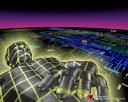XENA and its MOON
10TH PLANET?
I Guess They Forgot About Sedna
 The astronomers who in July announced the discovery of a "10th planet" in our Solar System say the object has a moon.
The astronomers who in July announced the discovery of a "10th planet" in our Solar System say the object has a moon. The new development comes as a result of observations made with the Keck Observatory on Mauna Kea, Hawaii.
Michael Brown, from the California Institute of Technology, US, says the find will help his team make a better determination of the new planet's mass.
Currently, the planet has been dubbed Xena; the moon will be called Gabrielle until official names are agreed.
Both "codenames" come from characters in a US TV series, Xena: Warrior Princess.
"Since the day we discovered Xena, the big question has been whether or not it has a moon," Professor Brown said in a statement.
"Having a moon is just inherently cool - and it is something that most self-respecting planets have, so it is good to see that this one does, too."
Big debate
Xena (it also has the designation 2003 UB313) has a highly elliptical orbit. It is currently 14.5 billion km (9 billion miles) away, about 97 times further away than the Earth is from the Sun.
The orbit is also tilted roughly 45 degrees above the orbital plane of the other planets.
KUIPER BELT OBJECTS
Icy planetary bodies that orbit beyond Neptune in the distant region of the Solar System
More than 400 such objects are currently known
They are believed to be remnants of the formation of the Solar System and among the most primitive objects available for study
The astonishing find has reignited the debate about what properties an object has to possess in order to be classed as a planet.
In Xena's favour is its size. With a diameter of perhaps 2,800km (1,700 miles), it is bigger than Pluto (2,390km; 1,500 miles), which has long had planet status. But this in itself will not be enough to convince doubters.
There are many scientists who believe that both Xena and Pluto are merely two largish objects in a huge population of rock-ice bodies orbiting the Sun in the far-distant region of the Solar System known as the Kuiper Belt.
To call them all planets would diminish the status of the truly massive bodies closer to the Sun, so the argument goes.
Hubble's eye
And having a moon is unlikely to push this debate further forward, as possession of a satellite is no guide to a planet's importance.
Both Mercury and Venus are devoid of moons, whereas some asteroids are known to have smaller rocks moving around them.
Indeed, Professor Brown said he expected to find a moon orbiting Xena because many of the Kuiper Belt objects so far discovered also have companions.
Gabrielle was seen using a 10m telescope at the WM Keck Observatory on 10 September. That it exists and orbits close to Xena is about all scientists know about the moon right now.
Professor Brown's team expects to learn more when it gets time on the Hubble Space Telescope in November.
Gabrielle's discovery will be reported officially in a scientific paper submitted to the Astrophysical Journal.

















<< Home